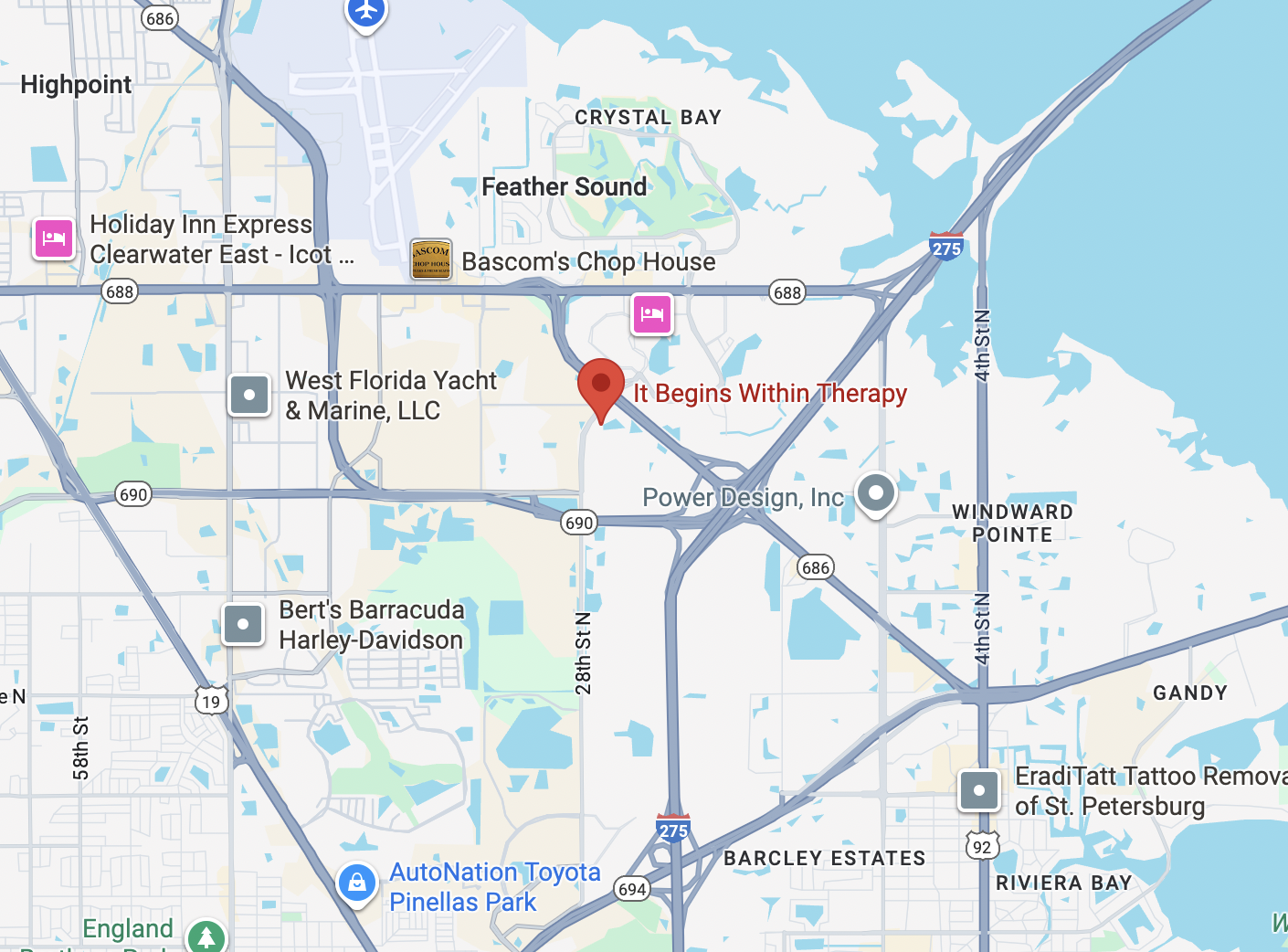Somatic Therapy in Tampa, St. Petersburg & Sarasota
At It Begins Within Healing Center, our licensed & specialized somatic therapists in Tampa, St. Petersburg, and Sarasota focus on body-based trauma healing and somatic experiencing. Using gentle, evidence-based somatic release techniques, we help you release what your body has been holding.
What Is Somatic Therapy?
Somatic therapy is a body-oriented approach that takes you past the point where talk therapy often plateaus. It recognizes that your body holds experiences that your mind has processed but hasn’t fully released.
Unlike traditional talk therapy that focuses primarily on thoughts and emotions, somatic therapy works directly with your body’s responses.
As Amanda Farris, LCSW, our somatic therapy specialist at It Begins Within, explains:
“Somatics allow us to figure out how to hold ourselves a little bit more where we are, accept ourselves where we are, and move through really intense things without having to tell the story or relive it.”
Through somatic experiencing techniques, gentle movement, breathwork, and mindful body awareness, you learn to release stored tension, regulate your nervous system, reconnect with physical sensations, and complete stress responses your body never finished.
Who Benefits from Somatic Therapy
Trauma and PTSD
If you’ve experienced trauma, your body remembers even when your mind wants to move on. Somatic trauma therapy helps you process trauma stored in your nervous system, reduce hypervigilance, reclaim safety in your body, and work through traumatic memories without retraumatization. Many clients combine Somatic Experience Therapy with EMDR therapy for comprehensive trauma treatment.
Chronic Anxiety and Panic
When anxiety lives in your body—tight chest, racing heart, shallow breath—somatic therapy for anxiety helps you interrupt panic cycles, ground during attacks, release muscle tension, and regulate your nervous system naturally.
Grief and Loss
Grief is more than emotion—it’s physical. Somatic therapy supports the body through the weight of grief, helping you move through stuck emotions and find release when tears won’t come.
Dissociation and Feeling Disconnected
If you feel numb, detached, or “not quite here,” somatic therapy helps you reconnect with your physical self, develop tolerance for being present, and feel safe in your body again.
Chronic Stress and Burnout
Somatic stress release techniques help you discharge accumulated tension, reset your baseline, and build resilience through practical, body-based tools.
Somatic Therapist in Tampa, St. Petersburg & Sarasota
Somatic Therapy Approaches
Somatic Experiencing THERAPY
Developed by Dr. Peter Levine, SE is a form of integrative body psychotherapy that focuses on your body's innate ability to restore balance. Therapy involves tracking physical sensations moment to moment, working in small manageable doses, and completing incomplete stress responses—helping your body return to calm and safety.
Sensorimotor Psychotherapy
This approach integrates movement and mindfulness with talk therapy. It helps uncover unconscious beliefs held in posture, gestures, and muscle patterns—and offers new, more adaptive physical and emotional responses.
Body-Centered EMDR
We integrate somatic awareness with EMDR trauma therapy, using the body to resource and stabilize, track sensations during processing, and ensure healing happens throughout your nervous system.
Polyvagal-Informed Somatic Therapy
Grounded in Dr. Stephen Porges’ Polyvagal Theory, this approach teaches you to recognize when your body is in fight/flight, freeze, or connection mode. By strengthening vagal tone, you learn to regulate emotions and increase stress resilience.
Somatic Skill Building: Relearning Safety Through the Body
Somatic therapy isn’t just about processing trauma—it’s about learning skills that help your body feel safe and capable again.
In session, your therapist helps you practice somatic skills that you can use every day, including:
Grounding: techniques to reorient to the present moment when overwhelmed
Tracking: noticing internal sensations without judgment
Pendulation: moving gently between activation and calm
Resourcing: using body sensations, imagery, or breath to restore safety
Containment: learning to hold strong emotions without being overtaken by them
Micro-movements: subtle shifts in posture or breath that release stored tension
These skills become the foundation for long-term emotional regulation and nervous system health. Over time, you’ll notice your body recovering faster from stress, feeling safer in stillness, and more connected to yourself and others.
What to Expect in Somatic Therapy Sessions
Your First Session
During your first session, your therapist will learn your story while observing how your body holds it—tracking posture, breath, and physical cues. You’ll practice simple grounding tools and collaborate on a trauma-informed treatment plan aligned with your nervous system’s needs.
What Sessions Look Like
You might be guided to notice subtle sensations—tightness in your chest, movement in your hands, or changes in breathing. As Amanda explains:
“Just a gentle observation of that sometimes allows the person to more deeply understand how this topic or issue is impacting them, and I think that’s really powerful in our healing.”
Somatic sessions may include mindful movement, breathwork, grounding, and emotional pacing. You’ll learn how to soften tense areas, approach discomfort safely, and work with your body instead of against it.
From Feeling Supported to Supporting Yourself
“It moves us from feeling supported to learning how to support ourselves,” Amanda says.
You won’t be asked to do anything unsafe. Somatic therapy is always paced to your nervous system’s readiness—you remain in control of what’s explored and how quickly you move.
Somatic Therapy Exercises to Try at Home
While working with a trained practitioner is best, you can start cultivating somatic awareness with simple practices:
5-4-3-2-1 Grounding: Identify 5 things you see, 4 you can touch, 3 you hear, 2 you smell, 1 you taste.
Somatic Breathing: Place one hand on your chest and one on your belly. Breathe slowly, focusing on expanding your belly to activate your parasympathetic (“rest and digest”) system.
Body Scan: Gently notice sensations from your feet upward. Allow sensations to exist without judgment—this builds awareness and calm.
These are starting points. Complex trauma and chronic patterns require the guidance of a licensed somatic therapist.
Somatic & Trauma Release Therapy in Florida
St. Petersburg Somatic therapist
Our St. Petersburg location serves Pinellas County, including Clearwater, Largo, Gulfport, and Seminole. Experience trauma-informed somatic therapy close to home in St. Pete.
Tampa Somatic Therapy
Our Tampa office near Westshore serves clients across Hillsborough County, including South Tampa, Hyde Park, Carrollwood, Brandon, and Riverview. If you’re searching for “somatic therapy Tampa” or “somatic therapist near me,” our conveniently located center offers a peaceful environment for healing.
Sarasota Somatic Therapy
Our Sarasota office welcomes clients from Lakewood Ranch, Bradenton, Venice, and Siesta Key. Find compassionate somatic practitioners who understand that true healing begins in the body.
Frequently Asked Questions About Somatic Therapy
Is somatic therapy evidence-based?
Yes. Research supports somatic approaches for treating PTSD, anxiety, chronic pain, and stress-related disorders by directly addressing the body’s physiological patterns.
How is somatic therapy different from regular therapy?
Talk therapy focuses on thoughts and emotions. Somatic therapy adds the missing piece—the body. It asks not just “What happened?” but “What’s happening in your body right now?” Together, they create deeper healing.
How long does somatic therapy take?
It varies. Some clients notice changes within weeks; deeper trauma work may take longer. Healing unfolds at your body’s natural pace.
Can I do somatic therapy virtually?
Yes—with adaptations. Many clients combine in-person and virtual sessions for flexibility and continuity.
Will somatic therapy help with anxiety, depression, or chronic pain?
Yes. Research supports somatic methods for anxiety regulation, trauma recovery, emotional connection, body-based approaches to depression and tension-related pain.
Who Can Benefit from Somatic Therapy — Adults, Children & Teens
Somatic therapy supports people of all ages by helping the body release what the mind alone can’t.
For adults, somatic work often creates the breakthrough that talk therapy couldn’t. It helps you unlearn protective patterns, heal attachment and relational trauma held in the body, and ease chronic tension or fatigue.
For children and teens, somatic therapy looks more like play. Our therapists use movement-based activities, creative regulation games, and parent coaching to teach kids how to calm their nervous systems and express emotions safely—without needing to find the perfect words.
Whether you’re an adult seeking relief from stress and trauma or a parent helping your child manage big emotions, somatic therapy offers body-based tools to restore balance and connection.
What are signs your body is releasing trauma?
As trauma releases from your body, you may notice physical sensations like tingling, warmth, trembling, or waves of emotion. You might experience yawning, deeper breathing, tears, or a sense of relief and spaciousness. Some people feel temporary fatigue or heightened emotions as their nervous system recalibrates. These are healthy signs that your body is completing incomplete stress responses and returning to balance. Your somatic therapist will help you recognize and safely navigate these release experiences.

Take the Courageous First Step Today
You don’t have to carry stress or trauma alone. Whether you’re in Tampa, St. Petersburg, or Sarasota, our licensed somatic therapists are here to help you reconnect with calm, safety, and balance in your body. Schedule a free, confidential consultation today and begin your healing journey.











